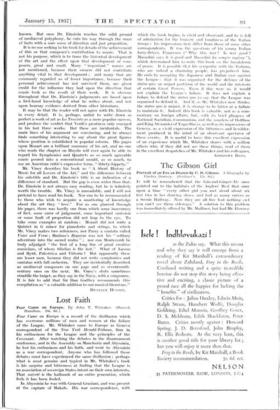Portrait of an Era as Drawn by C. D. Gibson.
A Biography by Fairfax Downey. (Scribner's. I2s. (id.)
The Gibson Girl
Jr will be remembered that the Gin-and-Ginger-Ale once pointed out to the habitues of the Anglers' Rest that once
upon a time " every other girl you met stood about six feet two in her dancing shoes. and had as many curves as a Scenic Railway. Now they are all five foot nothing uni you can't see them sideways." A solution to this problem was immediately offered by Mr. 'Milliner, but had Mr. Downey
teen present, he would have advanced his, that the change in the female form divine was due to the replacement of Charles Dana Gibson by John Held. Mr. Downey is a firm devotee of the doctrine that nature follows art and his book is not merely a " portrait of an era," but a description of how an era was moulded by an artist.
It is a theme worth developing and, had Mr. Downey a more critical or a more irreverent attitude, this book might
have been a minor Sartor Resartus or an acute discussion of the changes in the mores of the American people which have been made evident by the eclipse of the Gibson Girl.
But Mr. Downey is not that kind of writer and most of the criticism and reflection has to be supplied by the reader, aided by the lavish illustration. Mr. Downey reminds us, what might be forgotten, that Mr. Gibson was the illustrator of Richard Harding Davis and his irritatingly immaculate young men belong to that last manifestation of the " colonial mind," the pseudo-Kipling era in America when such dreary
and implausible figures as Van Bibber, or the slightly more tolerable engineer heroes of Soldiers of Fortune, were much
admired. Of that bogus English gentleman (with an American heart) type, Philo Vance is a remote descendant, but in the age of Clark Gable and Myrna Loy, of Peter Arno and Dorothy Parker, the gilded gentlemen and ladies of the late 'nineties seem very boring—or very funny. Mr. Downey tells us, what we might have guessed, that Mr. Gibson was
puzzled as well as pleased with Culter's series of drawings in Life, the " Gay Nineties." He rejoiced as an editor in their success ; he was suspicious as an artist at the impli- cat ions. It was not merely that the social scale was descended a little that the background was more like Mr. Booth Tarkington's Indianapolis than Mr. Gibson's Bar Harbor. There was concealed in those drawings a " dangerous thought," not only that the polished, naughty but so pure and correct society of the Gibson world was remote and dead enough to raise an easy laugh, but that it had never been alive.
Mr. Downey never asks himself how far the elaborate parlour games of the Gibson era were as frankly romantic ,and unreal. hs the- Rtnitania of Anthony Hope or the Olancho of Richard.. Harding Davis. - It. was not entirely because tastes change and the woman of the Gibson coiffure and the Gibson curve has been replaced by the shingled head and the wearer of -the " Bali form -that Life went down under Mr. Gibson's rule. As soon as America became conscious of herself and confident in her own values. even if the artist disliked the values, he had something to go on, some basis for his satire. The fate that made Mr. Gibson let Peter Arno escape to the New Yorker was not capricious. Peter Arno would have been no more at home on Mr. Gibson's Life than Mr. Gibson would have been at home in the world of Mr. O'Hara's Butterfield 8.
These reflections may seem over serious for what is ' a very entertaining picture book, but Mr. Downey provokes them by his title, by his reflections, by his allusions to Daumier. But his text, when not too serious for his -subject, provides a useful background to the pictures, though it is surprising
in such exalted society to read of " His Highness the Prince of Wales " and experts in courtesy titles may wonder a little about the Pipp marriage. It is also worth suggesting that the name of Zogbaum is chiefly associated with the pictures of war ships that did so much to bring about that Harding-Gibson conflict, the Spanish-American war.
D. W. BROCASL











































 Previous page
Previous page